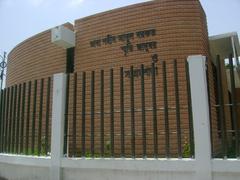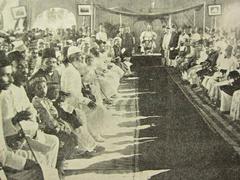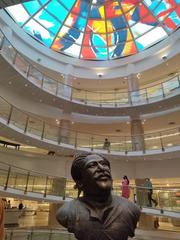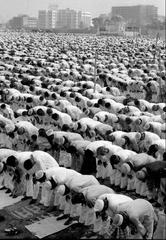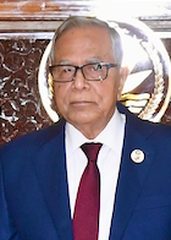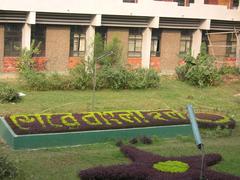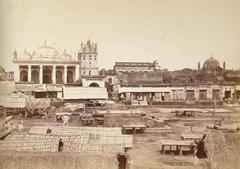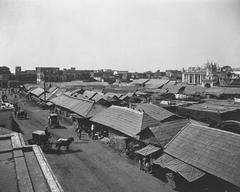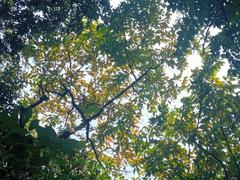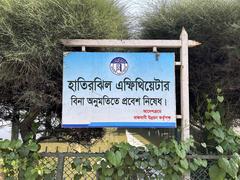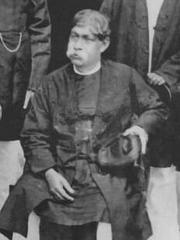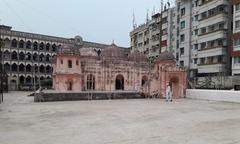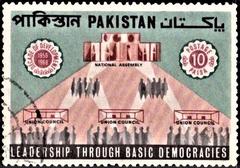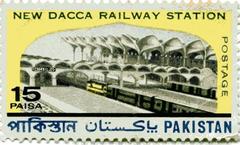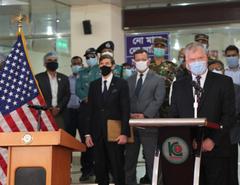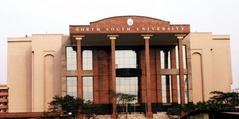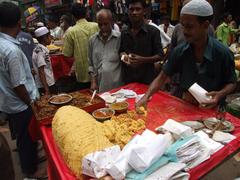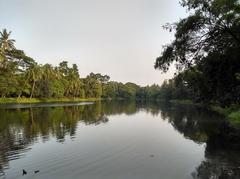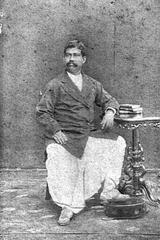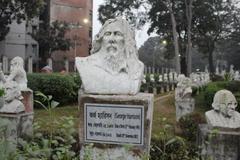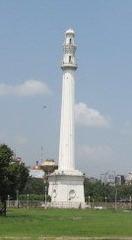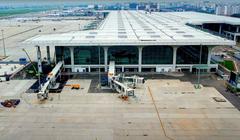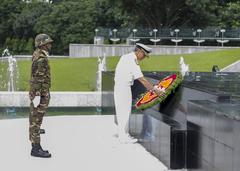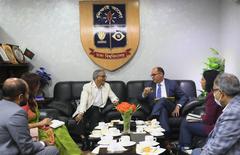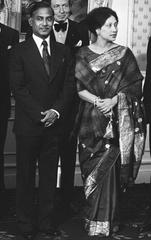Kakrail Mosque Visiting Hours, Tickets, and Dhaka Historical Sites Guide
Date: 04/07/2025
Introduction: Kakrail Mosque’s Historical and Cultural Significance
Nestled in the heart of Dhaka near the tranquil Ramna Park, Kakrail Mosque—also known as Malwali Masjid and Kakrail Markaz—serves as a monumental hub of Islamic faith and cultural heritage in Bangladesh. Established over three centuries ago by local gardeners and later associated with the Nawab family of Dhaka, the mosque has evolved from a humble tin-roofed structure into the national headquarters of the Tablighi Jamaat movement in Bangladesh. Since its pivotal transformation in 1952, Kakrail Mosque has played a central role in religious education, missionary outreach, and large-scale gatherings such as the Bishwa Ijtema.
The mosque’s architectural features—expansive verandas, unique triangular roof carvings, and extensive ablution facilities—blend functionality with spiritual symbolism. Its policy of 24-hour open access and free admission underscores a commitment to inclusivity, welcoming worshippers and visitors from all backgrounds. The mosque’s proximity to cultural landmarks like Ramna Park and Kakrail Church further highlights Dhaka’s tradition of interfaith harmony. This guide explores Kakrail Mosque’s rich history, architectural highlights, visiting details, leadership structure, and its enduring role in Bangladesh’s Islamic landscape, ensuring visitors can appreciate its multifaceted significance (Commonwealth Walkway; Everything Explained Today; Tourist Places BD; Wikipedia).
Contents
- Introduction
- Early Origins and Historical Development
- Role as Tablighi Jamaat Headquarters
- Architectural Features and Facilities
- Visiting Kakrail Mosque: Hours, Tickets, and Accessibility
- Travel Tips and Nearby Attractions
- Leadership and Governance
- The Shura System
- Factional Arrangements and Recent Developments
- Notable Religious Leaders
- Kakrail Mosque in Contemporary Islamic Life
- Frequently Asked Questions (FAQ)
- Visuals and Media
- Conclusion
Early Origins and Historical Development
Kakrail Mosque’s origins trace back over 300 years, beginning as Malwali Masjid—a simple place of worship built by the gardeners (“Malis”) of Ramna Park. The mosque’s location, in the Kakrail neighborhood close to Ramna Park, was chosen for its centrality and accessibility. Over time, it became a focal point for Islamic worship and community life in Dhaka, with the Nawab family playing a significant role in its early development (Commonwealth Walkway; Everything Explained Today).
Role as Tablighi Jamaat Headquarters
In 1952, Kakrail Mosque was designated as the Bangladesh headquarters (Markaz) for the Tablighi Jamaat, shifting from its previous location at the Khan Mohammad Mridha Mosque. Under the guidance of architect and engineer Haji Abdul Muqit, the mosque was reconstructed into a three-storey structure to accommodate the growing needs of the Tablighi Jamaat’s religious, educational, and missionary activities. This transformation established Kakrail as a national center for Islamic revival and outreach, hosting major events like the Bishwa Ijtema (Everything Explained Today).
Architectural Features and Facilities
Kakrail Mosque’s design reflects both traditional Islamic aesthetics and modern functionality:
- Wide Verandas: Three-sided verandas accommodate overflow crowds during major events.
- Distinctive Pillars and Roof Carvings: Square pillars and unique triangular roof motifs create a visually striking profile.
- Ablution Facilities: Large, pond-like wudu (ablution) areas on both sides of the mosque, with modern outdoor facilities for hundreds of worshippers.
- Open Access: The mosque famously lacks entrance doors, offering 24-hour accessibility.
- Supporting Structures: Adjacent two-storey buildings house restrooms and support facilities (Everything Explained Today; Wikipedia).
Inside, the prayer hall features high ceilings, intricate calligraphy, and a mihrab marked by elegant tilework. Separate prayer spaces and ablution areas are provided for women, ensuring inclusivity.
Visiting Kakrail Mosque: Hours, Tickets, and Accessibility
- Visiting Hours: Open 24 hours a day, seven days a week.
- Entry Fee: Admission is free for all visitors.
- Guided Tours: Official tours are not routine, but local guides can often be arranged through Dhaka travel services.
- Accessibility: Ramps and accessible ablution facilities make the mosque welcoming for people with disabilities.
- Dress Code: Modest attire is required; women are advised to wear headscarves. Shoes must be removed before entering the prayer hall.
- Photography: Permitted outside of prayer times; always seek permission before photographing people or during special events.
Travel Tips and Nearby Attractions
- Getting There: Located near Ramna Park, easily accessible by rickshaw, taxi, bus, or ride-sharing apps.
- Local Transportation: Uber and Pathao offer reliable options. Rickshaws provide an authentic local experience, while public buses are budget-friendly but crowded (Rome2Rio).
- Nearby Attractions: Ramna Park, National Museum, Dhaka University, and Kakrail Church (Archbishop House) are within walking distance.
- Best Times to Visit: Early mornings and late afternoons are quieter. For major religious events such as Bishwa Ijtema, plan ahead due to large crowds.
Leadership and Governance
The Shura System
Kakrail Mosque is governed by a seven-member shura (consultative council), overseeing religious programs, education, and mosque logistics (Commonwealth Walkway).
Factional Arrangements and Recent Developments
Two main factions alternate mosque administration:
- Zubair Ahmed Faction: Led by Maulana Zubair Ahmed, overseeing Bishwa Ijtema and key religious activities (The Business Standard).
- Saad Kandhalvi Faction: Followers of Muhammad Saad Kandhalvi, sharing mosque responsibilities on a rotating basis (RisingBD).
Government mediation in 2024–2025 maintained peaceful coexistence, restricting Maulana Saad’s visits and continuing major events under the Shurai Nejam council (Voice7 News).
Notable Religious Leaders
- Maulana Zubair Ahmed: Imam and leader of Tablighi Jamaat Bangladesh.
- Haji Abdul Muqit: Engineer behind the mosque’s significant mid-20th-century reconstruction.
Kakrail Mosque in Contemporary Islamic Life
Kakrail Mosque remains a central venue for Tablighi Jamaat’s missionary and educational activities, hosting major gatherings and fostering interfaith harmony with its open-door policy. Its leadership model balances tradition and adaptability, ensuring continued relevance in Bangladesh’s Islamic community (RisingBD; Voice7 News).
Frequently Asked Questions (FAQ)
Q: What are Kakrail Mosque’s visiting hours?
A: Open 24/7, accessible at any time.
Q: Is there an entry fee?
A: No, entry is free for everyone.
Q: Are guided tours available?
A: Not officially, but local guides can be arranged upon request.
Q: Is the mosque accessible for people with disabilities?
A: Yes, with ramps and accessible ablution facilities.
Q: What is the dress code?
A: Modest clothing; women should wear a headscarf.
Q: Can I take photos?
A: Respectful photography is permitted outside prayer times; always ask before photographing individuals.
Visuals and Media
To enhance your visit:
- Images: Include photos of the mosque’s exterior, ablution facilities, prayer hall, and special events, with alt text such as “Kakrail Mosque exterior view” and “Bishwa Ijtema at Kakrail Mosque”.
- Map: An interactive map pinpointing Kakrail Mosque and nearby attractions is recommended.
Safety, Etiquette, and Additional Tips
- Personal Security: Keep valuables secure and be cautious in crowds.
- Health: Drink bottled water and select food vendors with good hygiene.
- Respect: Maintain silence in prayer halls, remove shoes, and avoid interrupting prayers.
- Transportation: Use reputable ride-sharing apps or pre-arranged taxis for safe travel.
Conclusion
Kakrail Mosque stands as a beacon of faith, education, and community in Dhaka, embodying centuries of Islamic tradition and urban vitality. Its open-door policy, accessible facilities, and rich history make it a must-visit for pilgrims, history enthusiasts, and cultural travelers. Plan your visit to experience the mosque’s unique blend of spiritual significance and architectural beauty, and explore the diverse historical sites that surround it.
For more insights, guided tours, and updates on religious events, download the Audiala app and follow us for the latest on Bangladesh’s heritage sites.
